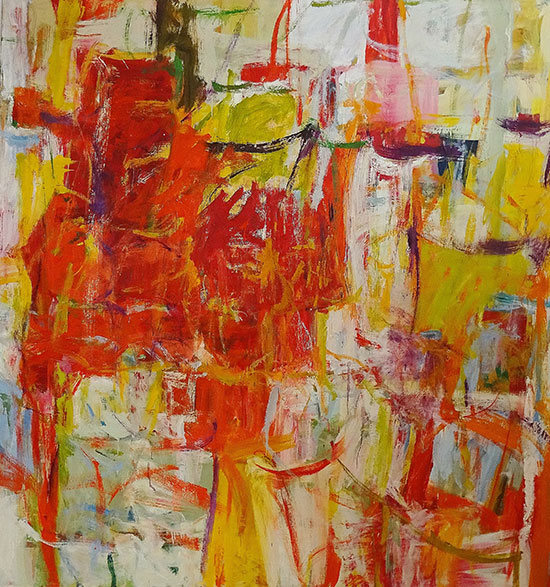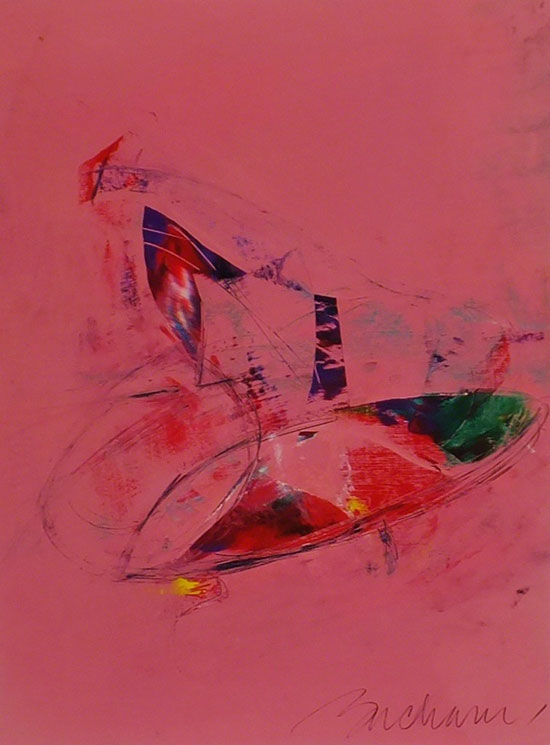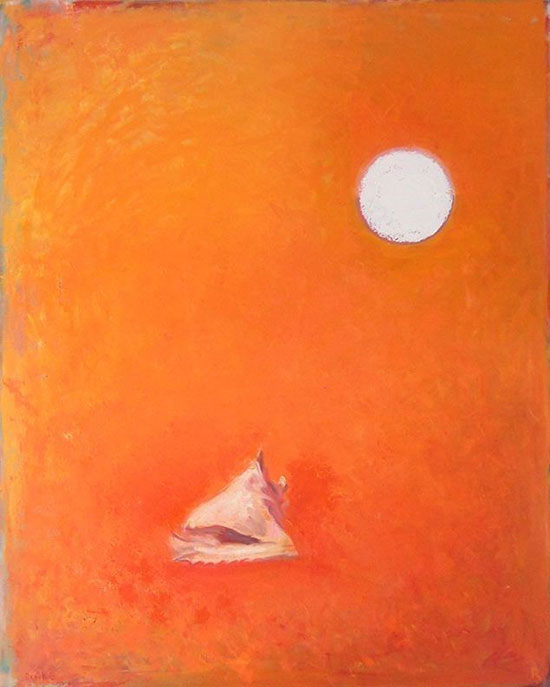Any questions I had initially about the premise of an exhibition of paintings by artists now in their 80s and 90s at Lawrence Fine Art in East Hampton were quickly answered as I was standing before Summer Joy, soaking up the scarlet and chartreuse passages laid down in 1960 by Diana Kurz and still glowing strong after all these years.
.

"Summer Joy" by Diana Kurz, 1960. Oil on canvas, 70.5 x 66 inches. Courtesy of Lawrence Fine Art.
.
Kurz was a student of Robert Motherwell, Phillip Guston, Phillip Pearlstein and Hans Hofmann. She was only 21 when she had her first exhibition (in 1959) and her painting hung next to one by Willem de Kooning at that time. Her showing in 2016 at the East Hampton gallery is a stirring example of the refusal to go gentle into senescence that is championed by Howard Shapiro, director of Lawrence Fine Art. With this show, he has flung down the gauntlet, challenging us to grant older artists a measure of respect.
“The art market is so hyper-contemporary today,” Shapiro said recently. “People tend to equate contemporary with young. These artists have been creating works of superb excellence for decades and continue to do so. They remain completely relevant. They in turn continue not just to paint but to teach and mentor."
A rhapsodic idyll made in the summer of 1960 by an Abstract Expressionist in her early 20s is one thing, but what should we expect from more recent work? The exhibition has a resounding answer to that question, and it has nothing to do with serenity, harmony and the resolution of deep philosophical anxieties that is supposed to attend old age. Instead, in the manner of Beethoven’s late piano sonatas, in which he set free a welter of expressive dissonances and textures, the paintings in the show burst with the vitality of new departures and restless excitement.
Consider, for example, Athos Zacharias, at 89 a force of nature judging by his wildly whirling Sufi, an oil on paper with blurred colors and sweeping gestures that whip past the eye just as the dancers spin, everything a blur. He had been Willem de Kooning’s first studio assistant, worked for Lee Krasner and Alfonso Ossorio, and has long been a popular East End figure. Elaine de Kooning once said, “His colors and forms always charge into the right place at the right time.” In his 80s, judging from the placement of the densest chromatic passages on the sheet of paper, his experience has offered him a sure sense of the tactical issues that allow him to confidently let those characters “charge” onto the field of battle.
.

"Sufi" by Athos Zacharias, 1998. Oil on paper, 20 x 15 inches. Courtesy of Lawrence Fine Art.
.
That same loud and voluptuous defiance of time and mortality is broadcast loud and clear by Harriette Joffe in figural works on a bold scale, such as Blue Maya, a secure life drawing rendered in monumental splendor with electric flashes of bright blue and pink to put to rest any sense of the “dying of the light.” Joffe was another of those insiders in the Hamptons, along with the de Koonings, Ibrim Lassaw, Philip Pavia and others. The nudes remind today’s students of Abstract Expressionism of the importance of life studies to the gestural vocabulary of the movement, which was far from wholly abstract.
In a show distinguished by the quality of several paintings, the works of Paul Resika stand out, especially the atmospheric orange and reds that drift across one another like vapors in the background of the surreally poetic Romance, made in 2012 when he was in his 90s. A native-born New Yorker, Resika is yet another Hofmann protégé who chaired the Parsons School of Design MFA program from 1978 to 1990. The mystical orange field reminded me of the pulsing tone used by Francis Bacon in his paintings of the 1980s, while the full moon and chalky white of the conch shell below, separated by a gap that reads like it is miles wide, are more like the delicate denizens of a landscape by Yves Tanguy.
.

"Romance" by Paul Reiska, 2012. Oil on canvas, 64 x 51 inches. Courtesy of Lawrence Fine Art.
.
The other Resika painting that should not be missed brings a candy-colored palette worthy of Wayne Thiebaud to a group of buoys arranged in a still life. The buoys are pinned with masterful elan to the plane of the canvas by an experienced hand, testimony again to the strength of the exhibition’s main idea. Simply put, if an artist has succeeded in the studio time and again with a combination of form and color, he or she knows where the dash of cobalt goes and how to make it stick with authority, just as an experienced athlete can anticipate the play and outsmart younger players who rush around the field unthinkingly.
In the watercolors of Amaranth Ehrenhalt, lozenges and disks of blue aquamarine and lilac intersect wet into wet with bands of saturated yellows and orange, a busily crowded space that has many of the characteristics of a Paul Klee. While so much of the show has its New York accent intact, Ehrenhalt’s vowels are Continental. She left New York for Paris, where she lived for 40 years. At the Café Select she met Beaford Delaney, Yves Klein and Alberto Giacometti, as well as Friedensreich Hundertwasser, who became her longtime significant other.
The layered, crowded color compositions of the two artists bear comparison, especially her Circles, made in 1968, which is more dense than the other work on view at Lawrence Fine Art. Her inclusion in group exhibitions in Paris brought her work together with paintings by Joan Mitchell and Sam Francis.
.

"Circles" by Amaranth Ehrenhalt, 1968. Watercolor on paper, 22 x 30 1/2 inches. Courtesy of Lawrence Fine Art.
.
With all the healthy joy in painterly substance on view, it was impossible to leave Lawrence Fine Art with any worries about the effects of aging. The shadows refused to show up for any kind of depressing meditation on death or decay. Color and light had the substance that paint can confer, when handled expertly.
When discussions of late work occur, the examples of Titian, Richard Strauss, W. B. Yeats and, of course, Picasso are held up as the defiant victors over time. Before visiting the gallery, I had just read a superb essay in the New York Review of Books by the Irish novelist Colm Toibin on the late paintings of Francis Bacon. Toibin compares the strangely protean, often disturbing works to the poetry of Yeats (as well as the later plays of Samuel Beckett, yet another Irishman who meditated on endings).
In Toibin’s profoundly insightful reading of Bacon, the artist begins anew in later life, foretelling what he knows about a future he will not experience: “Working is a way, in any case, of keeping such knowledge at bay at least for the time being, a way of confronting the material world, of outfacing it, as though time might actually relent or the spirit might gain more substance than anyone has ever before imagined.”
_____________________________
BASIC FACTS: “Works in Progress: Artists in their 80s and 90s” is on view at Lawrence Fine Art, 37 Newtown Lane (in the passageway), East Hampton, NY 11937. www.lawrence-fine-arts.com
_____________________________
Copyright 2016 Hamptons Art Hub LLC. All rights reserved.
